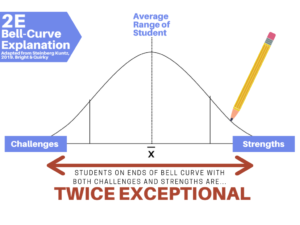“It is a well-kept secret that a child can be both gifted and challenged”
– Linda Kreger Silverman (1989)
Within this resource is an introduction for those who are beginning their journey of learning about Multi-Exceptionality (often termed 2E, twice exceptional) in children. To begin, giftedness in children is broadly shown through abilities or talents that are above same age-peers. Additional information on giftedness can be found on our “New to Gifted” and “Useful links” pages of the GCABC website.
In general, Twice Exceptional or 2E is a term representing children who are gifted and also have an additional special need. This means these children are quite complex, being both “gifted and talented” and also having other special needs such as a Learning Disability or Attention Deficit and Hyperactivity Disorder (ADHD).

Broadly we can think of children with twice exceptionalities as being:
“Considered gifted and is formally diagnosed with one or more disabilities.”
These children are dually exceptional and have distinct needs due to the unique combination of two or more exceptionalities. They fall into their own unique subgroup that is different from any other population such as gifted children or children with Learning Disabilities. Children who are Twice Exceptional can appear in any demographic group and personality type. Like other gifted learners, 2e students are highly knowledgeable and talented in at least one particular domain. If this is recognized within the school system, 2E children would also be formally diagnosed with demonstrated provincial criteria for a disability which can lead to further support in the educational system. It is important to remember that not all gifted children look or act alike. Overall, each Twice Exceptional child has a unique mix of strengths and weaknesses which impacts their cognitive, psychological, and academic needs.
Twice Exceptional students often have asynchronous development which refers to an uneven intellectual, physical, and emotional development. In average children, these three domains of development usually advance at a similar rate. Gifted and twice exceptional children develop unevenly across these three domains displayed with high capabilities and a lagging skill (Steinberg Kuntz, 2019).
Do you think you may have a twice exceptional child? American Psychologist and Advocate Linda Silverman recommends a Checklist for Recognizing Twice Exceptional Children, created by the Gifted Development Centre in the United States.
For more detailed information, browse the GCABC Members Corner.
